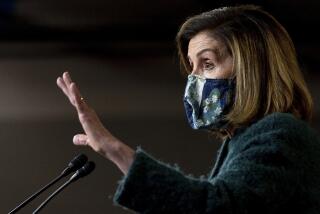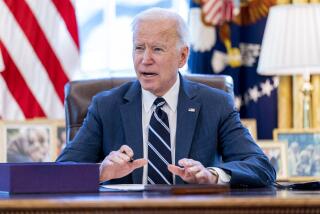Obama confronts doubts on stimulus, vows faster spending
- Share via
WASHINGTON — President Obama billed it as an adrenaline jolt -- a $787-billion stimulus package that not only would put people back to work, but also underwrite construction and energy projects the country had long neglected.
But with the economy still sputtering and some experts doubting the program was meeting its goals, Obama vowed Monday to accelerate stimulus spending with the goal of creating or saving 600,000 jobs by summer’s end.
Opening a meeting with Cabinet members and Vice President Joe Biden, Obama sought to claim substantial progress while holding down expectations.
“We’ve done more than ever, faster than ever, more responsibly than ever, to get the gears of the economy moving again,” Obama said, and “we’re in a position to really accelerate.” Still, he acknowledged that job losses -- while lower than expected in May -- remained high. “We’re still in the middle of a very deep recession,” he said, and “it’s going to take a considerable amount of time for us to pull out.”
Results of the stimulus spending are difficult to measure, and so far the promised federal money has been slow in coming. As of May 29, just over 100 days since Obama signed the bill into law, only about 6% of the funds had been spent.
And on the jobs front, an early target was missed: Two of the president’s top economic advisors put out a report Jan. 9 predicting that with the stimulus spending, the U.S. unemployment rate this year would not exceed 8%. It now stands at 9.4%. That figure is higher than Christina Romer and Jared Bernstein had said it would be even if the stimulus package had not been adopted.
“A lot of this is hokum. All along, [Obama’s] job numbers have kept changing according to the political environment,” said Peter Morici, a professor of international business at the University of Maryland.
Kevin Hassett, director of economic policy studies at the American Enterprise Institute, a conservative-leaning think tank in Washington, put it even more bluntly: “The actual unemployment rate is worse than their baseline -- suggesting that their stimulus plan was harmful. And yet, despite that, they’re asserting it has been successful. That shows an incredible amount of gall.”
Guesstimates
Obama has said the stimulus package has saved or created 150,000 jobs already and continues to pay off. Those numbers appear to be elastic, though: On a Sunday-morning news show, his senior advisor David Axelrod said the plan “has produced hundreds of thousands of jobs.”
Any figure involves guesswork, the administration has conceded.
Bernstein, who is Biden’s economic advisor, said in an interview that the president’s citation of 150,000 is “an estimate” based partly on what the economy would look like in the absence of the stimulus package. But Bernstein said he could not break down how many of those jobs were created versus saved. “That’s a division we’re not able to make at a level of accuracy we’re comfortable with,” he said.
Republicans are arguing that the stimulus package has failed.
“In order to achieve Keynesian economic nirvana,” Rep. Jeb Hensarling (R-Texas) said Monday, “one has to spend the money essentially on bricks and mortar and get the money out the door quickly.” Hensarling said he was not a fan of economist John Maynard Keynes, who advocated government intervention, including deficit spending, to address severe downturns.
At this point, the largest share of stimulus spending has gone to states in the form of Medicaid grants, federal records show.
Though some signs suggest the recession is abating, the economy lost about 1.5 million jobs over three full months after the passage of the stimulus bill, from March through May. Unemployment in that period jumped to 9.4%, from 8.5%.
The White House has said conditions would be even worse without the stimulus package. But the public may be getting impatient.
A Gallup Poll released Monday showed that though Obama is personally very popular, people are not as happy with his stewardship of parts of the economy. Fifty-one percent disapproved of Obama’s performance controlling federal spending, compared with 45% who approved.
What’s ahead
Obama himself said he was “not satisfied” with the progress thus far. In the White House meeting, he said: “The biggest concern that I have moving forward is that the toll that job losses take on individual families and communities can be self-reinforcing.
“People lose jobs, they pull back on spending, that means businesses don’t have customers, and suddenly you start seeing more job layoffs. Our whole task here with the [stimulus] is to reverse that negative cycle . . . and it’s going to take some work.”
In the next phase of the stimulus plan, the White House said, the emphasis will be on helping families cope with the recession and underwriting construction projects that are ready to go. Priorities will include improving airports and highways; hiring or retaining 5,000 law enforcement officers; starting or accelerating cleanup of 20 hazardous waste sites; and creating 125,000 summer jobs.
The costs of all that are unclear. Bernstein said he did not know how much would be spent to create or save the 600,000 jobs. “It’s a fair question,” he said. “We’ll absolutely keep you posted.”
Obama administration officials said thousands of construction projects are in the pipeline. The Transportation Department, for example, is planning highway bridge and airport runway projects that will draw on billions in stimulus money.
But what is needed, Republicans said, are jobs that will be permanent.
House Minority Whip Eric Cantor (R-Va.) said in an interview: “The American people understand what a job is when they see it. And clearly, having lost over 2 million jobs this year and after having spent almost $800 billion, I wouldn’t say that’s necessarily a good return on your investment.”
--
Times staff writer Jim Puzzanghera in Washington contributed to this report.
More to Read
Get the L.A. Times Politics newsletter
Deeply reported insights into legislation, politics and policy from Sacramento, Washington and beyond. In your inbox twice per week.
You may occasionally receive promotional content from the Los Angeles Times.








